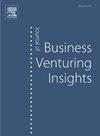从橡子到橡树:为可持续性和多样性设计创业生态系统
Q1 Business, Management and Accounting
引用次数: 0
摘要
“让我们用生态学家管理栖息地的方式来管理创业生态系统”——这是安德烈亚斯·库克茨提出的挑战。然而,对于在实践中寻求建立这样的栖息地的行动者,文献仍然缺乏具体的指导。为了解决这一差距,我提出了“从橡子到橡树”(A2OT)框架,这是一个设计科学的产物,它将生态系统的可持续性嵌入其中——这里的定义是,随着时间的推移,创业生态系统保持适应性、包容性和对各种风险类型的支持的能力融入到它们的结构设计中。利用Romme和Dimov的迭代设计科学逻辑,我将生态系统配置、弹性和实践者智慧的研究提炼成四个设计原则:多样化种子库、富营养土壤、支持性气候和生态系统维护。这些原则与动态反馈循环模型和背景-机构-机制-结果(CAMO)表相结合,该表为决策者、投资者和支持组织确定了可操作的杠杆。这篇设计科学论文将库克茨的生态隐喻转化为一个实践者准备好的框架,通过将可持续性和创业多样性作为核心设计目标来扩展创业生态系统理论。它还说明了设计科学方法如何产生可测试和可操作的知识。本文的主要观点是,生态系统的可持续性可以通过嵌入支持风险多样性、适应性和长期弹性的机制来进行结构性设计。本文章由计算机程序翻译,如有差异,请以英文原文为准。
Acorns to Oak Trees: Designing entrepreneurial ecosystems for sustainability and diversity
“Let's manage entrepreneurial ecosystems the way ecologists manage habitats”—that is the challenge posed by Andreas Kuckertz. Yet the literature still lacks concrete guidance for actors who seek to build such habitats in practice. Addressing this gap, I present the Acorns-to-Oak-Trees (A2OT) framework, a design-science artefact that embeds ecosystem sustainability—defined here as the ability of entrepreneurial ecosystems to remain adaptive, inclusive, and supportive of a variety of venture types over time—into their structural design. Using Romme and Dimov's iterative design-science logic, I distil research on ecosystem configuration, resilience, and practitioner wisdom into four design principles: Diverse Seed Bank, Nutrient-Rich Soil, Supportive Climate, and Ecosystem Maintenance. These principles are coupled with a dynamic feedback-loop model and a Context–Agency–Mechanism–Outcome (CAMO) table that identifies actionable levers for policymakers, investors, and support organizations. This design science paper translates Kuckertz's ecological metaphor into a practitioner-ready framework, extending entrepreneurial ecosystem theory by making sustainability and entrepreneurial diversity core design objectives. It also illustrates how design-science methods can generate testable and actionable knowledge. The paper's key insight is that sustainability in ecosystems can be structurally designed by embedding mechanisms that support venture diversity, adaptability, and long-term resilience.
求助全文
通过发布文献求助,成功后即可免费获取论文全文。
去求助
来源期刊

Journal of Business Venturing Insights
Business, Management and Accounting-Business and International Management
CiteScore
11.70
自引率
0.00%
发文量
62
审稿时长
28 days
 求助内容:
求助内容: 应助结果提醒方式:
应助结果提醒方式:


